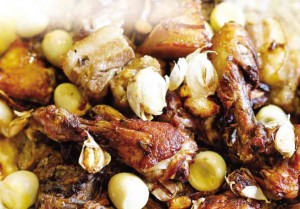
She didn’t know how to cook until she got married, which was quite surprising for a true-blue Kapampangan. But, as soon as she tried her hand in the kitchen, there was no stopping Isabelita “Ningning” de Ocampo from whipping up delicious meals for her family.
“Kapampangans are known to be good cooks,” says De Ocampo. “I grew up eating the right flavor and precise taste of food, so when I was trying to learn how to cook myself I would look for that specific taste the way I remembered it.”
De Ocampo grew up in Tarlac City, but her parents hailed from Mexico and Lubao, Pampanga.
One dish she was fond of eating and eager to cook was her mom’s adobong puti, a chicken-and-pork stew devoid of soy sauce. The version, recalls De Ocampo, was more sour than salty. The sauce was more runny than thick. The saline taste would simply come from rock salt.
“I came up later on with my own adobo style,” she adds.
De Ocampo adapted the Tagalog adobo that makes use of soy sauce to give the quintessential dish a nice dark brown color.
Her “Tagalized version” has the usual vinegar, garlic, whole peppercorn, soy sauce and salt, minus the bayleaf (or laurel). Kapampangans don’t use laurel, says De Ocampo.
Unlike others who first sauté the garlic and meat before blending the seasonings, De Ocampo simply put everything in a deep pan with enough water to tenderize the meat.
She positions the pork liempo under the chicken because pork takes longer to cook, and then covers the pan. Once it boils, she lowers the flame and lets it simmer for a few more minutes. She takes out the meat from the pan and fries the meat until it’s a bit crunchy in texture. The fried meat then goes back into the already simmering broth.
The flavors, says De Ocampo, always intensify and develop while the dish is fried and reheated.
Thick sauce
She likes her adobo sauce thick with oil. She uses pork belly with all its fatty layering because the fat adds richness to the dish. The chicken liver also lends the dish a rounded taste.
The end result is soft, succulent, and subtly seasoned and spiced chicken-pork adobo. The salty-sour blend is not at all overpowering. Just before serving, De Ocampo garnishes the adobo with hard-boiled quail egg and fried garlic.
De Ocampo, who finished Food and Nutrition at the College of the Holy Spirit, also makes sure nothing goes to waste when cooking.
After cooking adobo and presenting it in a nice platter, she pours in a few cups of rice onto the adobo pan and mixes it gently to scrape off the remaining adobo flavor and the bits and pieces of meat sticking to the pan.
“You will have adobo rice in an instant,” shares De Ocampo, who got married at 22 and now has seven grown-up children with Kapampangan husband Benny de Ocampo.
De Ocampo pairs her adobo with pinakbet or crispy hito with buro and steamed okra. Interestingly, she cannot eat her adobo without patis (fish sauce) and calamansi dip on the side.
“For me, the patis-calamansi sauce helps neutralize the richness of the adobo,” she explains.
Growing family
Through the years, De Ocampo has developed a passion for cooking. In her spare time, she reads recipe books and attends private cooking lessons. She likes cooking Filipino favorites such as sisig, kaldereta, relleno, etc.
Apart from adobo, her children enjoy her sinigang, lengua with mushroom sauce, and Spam in mushroom soup.
Among her children, it is her third child Ma-an de Ocampo-Ignacio who has picked up her mother’s love for cooking. She helps run the family restaurant business Quattro (Timog, QC, and Dagupan City) and Nation Bar and Grill (Scout Borromeo, QC).
“These days, my daughter Ma-an takes charge of cooking whenever there’s a gathering in the house,” says De Ocampo. “I have lower back pains and cannot stay too long in the kitchen. I just cook if I need to cook for very special occasions.”
When the family hosts dinner at home, De Ocampo and Ignacio collaborate in planning the menu. Most of the time, there are three food stations for guests to enjoy: Japanese, Filipino and Spanish.
If she wants to try a new dish that she saw on Facebook or read in food magazines, De Ocampo whips it up in her bedroom, which has a mini kitchen complete with dining table, microwave, toaster and water dispenser.
“I still develop the dishes for our restaurants. Even if I’m semi-retired, I still can’t take out cooking good food out of my system,” says De Ocampo.
On weekends, the family checks out new food places.

Chicken Pork Adobo with Chicken Liver and Quail Eggs
Ingredients
- 1½ kg pork liempo
- 1½ kg chicken
- ¼ kg chicken liver
- 3 garlic bulbs, unpeeled and crushed
- 1 tsp black whole peppercorn
- 1 c vinegar
- 1 c water
- 1 tsp rock salt
- 3 tbsp soy sauce
Combine pork, chicken, garlic, pepper, salt, water, vinegar and soy sauce in a deep pan. Cover and bring to a boil until pork is tender. Don’t stir until after it boils. Lower the flame. Adjust taste to your liking.
After the adobo is cooked, take out the meat and fry in its own oil. Add fried meat to the already simmering adobo sauce or simply pour the adobo sauce onto the fried meat. Let it simmer. Garnish adobo with hard-boiled quail eggs and fried garlic.
PHOTOS BY ALANAH TORRALBA









































